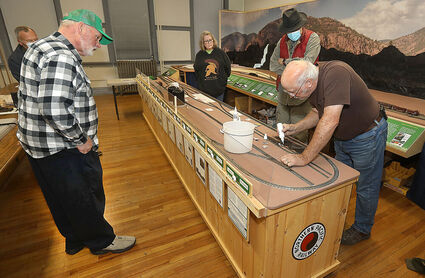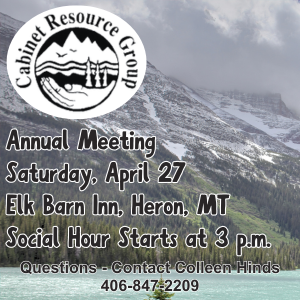Paradise railroad progresses
November 18, 2021

Ed Moreth
GROUNDWORK – Mac Hall demonstrates how to apply ballast, which is comprised of cinder and crushed rock, around the railroad tracks for ground cover.
The Paradise Center has a new club that will hopefully encourage more participation in working on one of the center's main displays.
The Paradise Center Railroad Club, which presently has a handful of "members" to work on the railroad display located on the main floor. Dave Colyer of Paradise and Mac Hall of Plains have been heading the project, which started in 2017. Colyer said the COVID pandemic has stifled progress, but he feels the group has come a long way. They've had workshops and a few serious railroad hobbyists helping, but he thinks they probably have about another three years of work left. "The railroad club is a tool to recruit people to join our efforts and complete the displays. We are hoping to get some younger people involved," said Colyer.
Others working on the display include John and Karen Thorson, Cheri Seli, and Kathleen Hubka. Hall gave a class on working on the structures last Wednesday at the Paradise Center. Though they didn't get any hands-on working time, Hall went over some of the procedures and showed the group the numerous tools he has used in his more than 60 years as an HO scale railroad hobbyist. Hall has donated model trains to the exhibit and has cleaned up and repaired trains that were donated by others.
"I really want to work on the buildings. I am very interested in recreating the Paradise of the era when it was a booming railroad town," said Hubka, who attended Hall's class. John Thorson would also like to build houses on both displays. Karen will be painting the Styrofoam mountains that have been situated as part of the display background.
Hall had a large selection of tools and accessories in his kit, ranging from toothpicks to electric dremels. The Paradise Center has purchased some tools, but some of the builders plan to buy their own in order to work on the small structures at home. Hall said they can utilize HO scale building kits, but might have to tweak some of the structures to look as close as possible to original ones. Hanson said some of the town residents' homes still in use now were bungalows used by railroad employees around 1910. Don and Judy Stamm live in one of the railroad's "executive" homes built in the same era.
The display is separated on two custom made display tables. One table is 27 feet long and has some 70 feet of train track. It will have the roundhouse and the town of Paradise. The other table will have the tie plant and support buildings, track, and railroad workers' residents. Colyer said the group is now concentrating on the structures in the tie plant display. He believes there will be at least 15 buildings, including eight to 10 residential buildings. Colyer worked for the Northern Pacific Railroad at the tie plant from 1974 to 1982, the year the plant burned down. He said there will probably be more than 20 buildings for the town display, including Paradise Elementary School, which was built in 1910.
Colyer, Hall and Marc Childress have already made some of the structures, but none are totally finished. They need trim, doors, siding, and windows. "Some will be built from scratch because kits are not available," said Colyer. Terry Christensen of Plains has been working on the roundhouse on and off for about three years. It is one of the largest railroad structures of the exhibit and is a museum quality kit that cost around $900.
The roundhouse at Paradise was in operation from 1907 to 1937, according to Benita Jo Hanson, who wrote the book "Milepost Zero," which is a history of the railroad in Paradise. Hanson attended Paradise School from 1952 to 1961 and is one of the display coordinators. Hanson is not making any structures, but she developed the plans for them. Like Colyer, Hanson has a personal connection with the railroad. Her father, Jess "Butch" McNeeley, worked for the railroad for 20 years and she lived in two different railroad residential units. Organizers are using numerous photographs, including some that Hanson shot herself when she was a kid. She said they're also using pictures from local newspapers and railroad magazines. They also have used Northern Pacific Railroad color cards, which were used by the railway to ensure color standards on their buildings, said Hanson.
The display is supposed to be a representation of the town and railroad operations of the 1930s. Colyer, who serves as vice president of the Paradise School Preservation Committee, will be building the retort structure, the main tie plant building. It was at the retort building of the tie plant where the untreated ties went through a boring machine before being pressure treated with creosote and burner oil. "The retort at the tie plant is likely the second biggest building. I did some estimating on the retort height and think it was around 50 feet tall at its highest," said Colyer, which will convert to about 15 inches in the HO scale. The railroad exhibit used to share a space with a school classroom display in the 640 square feet room, but the class was moved to the third floor, allowing the railroad to have its own room.
Hall also demonstrated the method of applying ballast - cinder and crushed rock - around the railroad tracks for ground cover. He used actual cinder from a pit near the old roundhouse. Hall used a mixture of diluted glue - three parts water and one part glue - to adhere the ballast to the display top and prevent it from being blown away.
Colyer hopes to have weekly workshops and recruit additional train modelers. "If modelers are willing to do a weekend now and then I am in favor of doing it," said Colyer. Presently, they are concentrating on the tie plant display, but Colyer said they could work on both displays if they can get more volunteers.
The Paradise School Preservation Committee received two grants from the Northern Pacific Railway Historical Association, one for $5,000 and another earlier this year for $2,000, but Colyer said they received over $1,000 in private donations. "Most of this donated money was given to fund specific projects we are working on," he said, but he added that they need more money to match the grant money. People can send donations to the Paradise Center, Box 162, Paradise, MT, 59856.
He said the Northern Pacific Railway Historical Association is a big advocate of the Paradise Center's railroad display and invited Colyer and others to do a presentation at their annual convention next September. "I'm pleased with all the progress and even with Covid messing things up for two years. This railroad display is really shaping up," said Colyer.







Reader Comments(0)